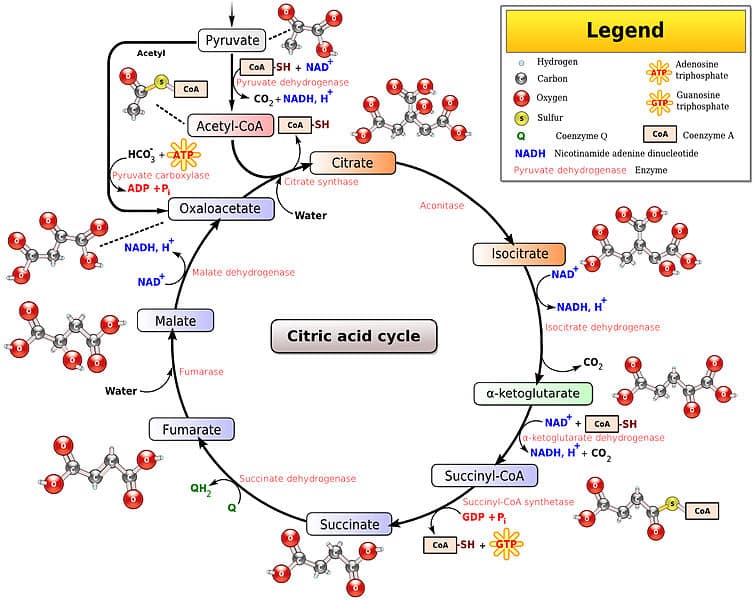In order for ATP to be produced through oxidative phosphorylation, electrons are required. This allows ATP to pass down the electron transport chain. These electrons come from electron carriers such as NADH and FADH₂, which are produced by the Tricarboxylic Acid Cycle (TCA cycle, also known as the Kreb’s/Citric Acid cycle).
In this article, we will outline the steps and regulation of this essential part of cellular physiology.
Link Reaction
Prior to the TCA cycle, glycolysis has occurred, which generates molecules including pyruvate, ATP, and NADH. Pyruvate is then decarboxylated to form acetyl-coA by the pyruvate decarboxylase complex. Acetyl-CoA is the intermediate that then enters the TCA cycle.
The TCA Cycle
The TCA cycle is a central pathway that provides a unifying point for many metabolites, which feed into it at various points. It takes place over eight different steps:
- Step 1: Acetyl CoA (two-carbon molecule) joins with oxaloacetate (four-carbon molecule) to form citrate (six-carbon molecule).
- Step 2: Citrate is converted to isocitrate (an isomer of citrate)
- Step 3: Isocitrate is oxidised to alpha-ketoglutarate (a five-carbon molecule) which results in the release of carbon dioxide. One NADH molecule is formed.
The enzyme responsible for catalysing this step is isocitrate dehydrogenase. This is a rate-limiting step, as isocitrate dehydrogenase is an allosterically controlled enzyme.
- Step 4: Alpha-ketoglutarate is oxidised to form a four-carbon molecule. This binds to coenzyme A, forming succinyl CoA. A second molecule of NADH is produced, alongside a second molecule of carbon dioxide.
- Step 5: Succinyl CoA is then converted to succinate (four-carbon molecule) and one GTP molecule is produced.
- Step 6: Succinate is converted into fumarate (four-carbon molecule) and a molecule of FADH₂ is produced.
- Step 7: Fumarate is converted to malate (another four-carbon molecule).
- Step 8: Malate is then converted into oxaloacetate. The third molecule of NADH is also produced.

Fig 1 – Diagram showing the steps of the TCA cycle
While the primary role of the TCA cycle is the production of NADH and FADH₂, it also produces molecules that supply various biosynthetic processes. These enter or exit the cycle at various points depending on demand. For example, alpha-ketoglutarate can leave the cycle to be converted into amino acids, and succinate can be converted to haem.
Net Output
Each cycle produces:
- Two molecules of carbon dioxide.
- Three molecules of NADH.
- Three hydrogen ions (H+).
- One molecule of FADH₂
- One molecule of GTP.
Each molecule of glucose produces two molecules of pyruvate, which in turn produces two molecules of acetyl-CoA. Therefore, each molecule of glucose produces double the net output of each cycle.
Regulation of the TCA Cycle
This process is regulated in a variety of ways:
- Metabolites: Products of the cycle provide negative feedback on the enzymes that catalyse it. For example, NADH inhibits the majority of the enzymes found in the cycle.
- Citrate: Inhibits phosphofructokinase, a key enzyme in glycolysis. This reduces the rate of production of pyruvate and therefore of acetyl-CoA.
- Calcium: Accelerates the TCA cycle by stimulating the link reaction.
Clinical Relevance – Defects of the TCA Cycle
There are in fact no known defects of the TCA cycle that are compatible with life. This highlights the importance of this step in ATP production for sustaining life.
